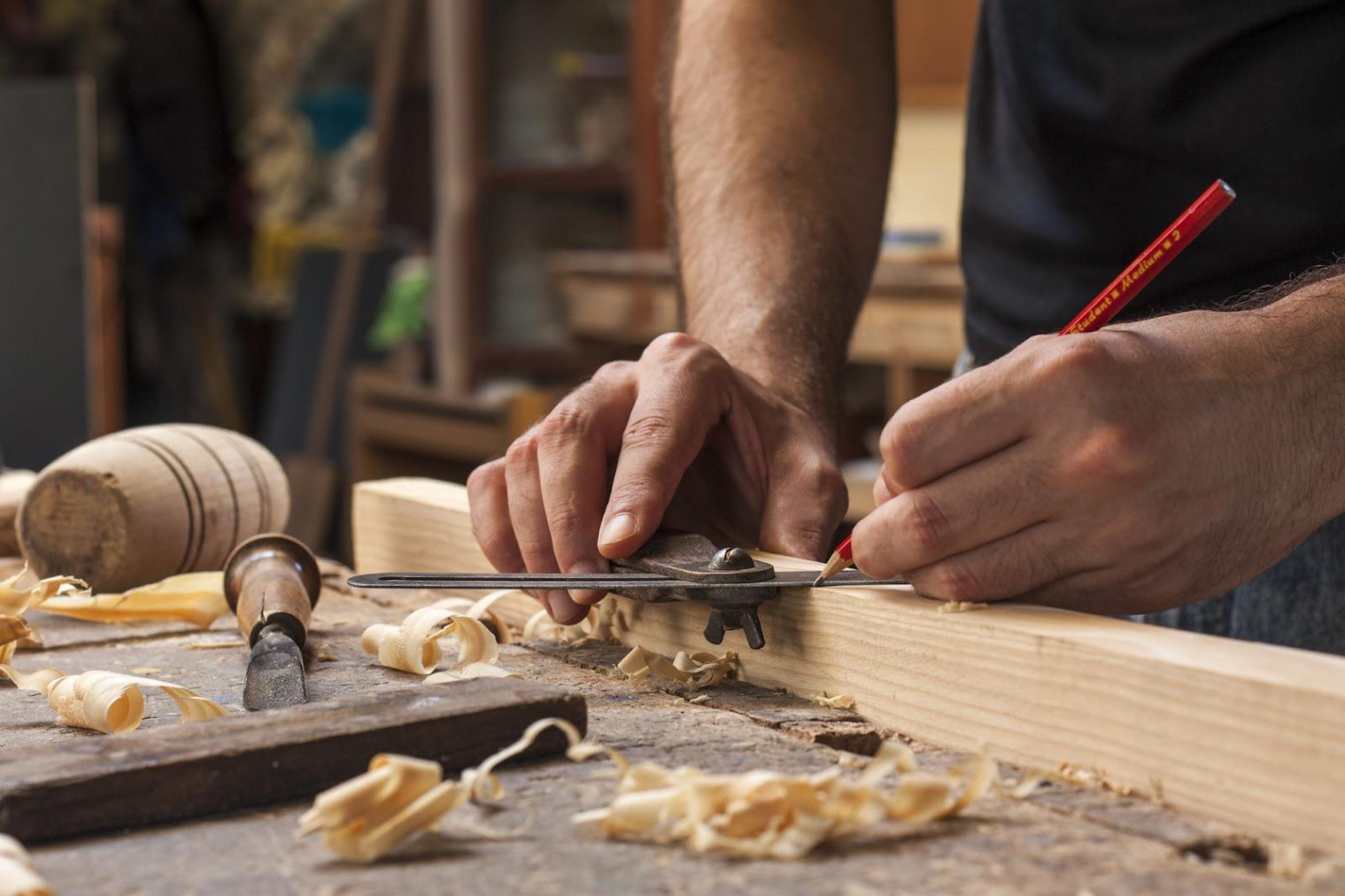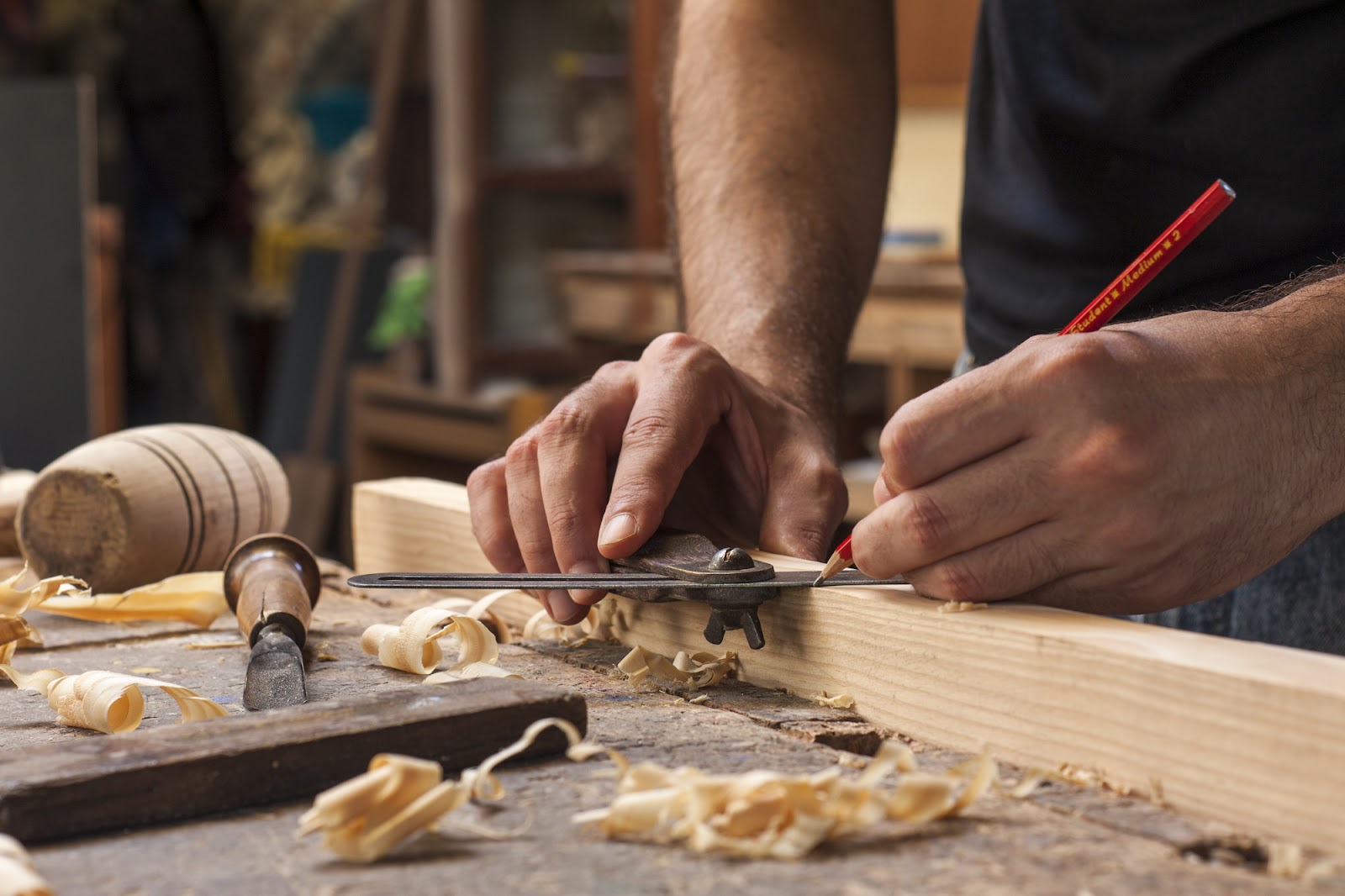July 24th, 2022

Woodworking for Beginners
Having a hobby has several mental health benefits, including reduced stress and decreased depression and anxiety. Woodworking can be a great hobby for those who are detail-oriented, enjoy working with their hands, and don’t mind getting a little dirty. Woodworking can also be what you make it — whether you want a more independent hobby or a pastime you can share with your children or grandchildren.

It is also a great, scalable hobby. You can participate in the hobby with simple tools like a knife and some wood, or invest more by building a workshop and buying different sawing equipment. As a beginner woodworker, there are several avenues that you can take to start creating.
Types of Woodworking
While the medium may be limited, the types of art you can create with woodworking are certainly not. There are several ways in which you can treat, carve, shape, or even dye or burn wood to create art. Some of these ways include:
- Wood carving: Wood carving and whittling are the sculpture of wood into new shapes. You can start wood carving with nothing more than a sharp knife, or you can use a fuller set of tools — whichever you prefer. Wood carving can be a great place to start as a beginner woodworker by practicing skills like angling and shaping.
- Pyrography: Also called wood burning, this type of woodworking uses fire and heat to burn different patterns or shades into a piece of wood.
- Scroll Sawing: This refers to using a specific tool, a scroll saw, that allows you to start your cuts on the inside of a piece of wood and work outwards. This is great for making things like ornaments, where you utilize the positive space instead of the negative space.
- Intarsia and Marquetry: Also called wood mosaics, this type of woodworking can accumulate many different types of wood into the same piece, using things like wood chips or shavings to create a mosaic. This can be a great option for woodworkers who don’t want to waste their scraps.
Any of these different types of woodworking can be used separately or together, depending on your vision for your project.
Woodworking vs Carpentry
While woodworking and carpentry may seem similar and have some overlapping skills, they are different crafts. Carpentry is considered the specific use of wood and timber in the construction of buildings, while woodworking is considered the use of wood to make crafts, sculptures, or furniture. Because of these differences, carpentry is usually done on a much larger scale, which may demand a more intent understanding of geometry and angles.
You can use skills from both to enhance either practice, and you can even turn woodworking and carpentry into your profession.
Woodworking Terminology and Basics
Like any craftsmanship, woodworking has a language all its own. As a beginner woodworker, these are some of the most important terms for you to know:
- Workpiece: This term is used to refer to the piece of wood you’re currently working with/on.
- Square: This refers to the edge of a workpiece that is at a 90-degree angle. An entire workpiece can be square if all the edges are 90 degrees.
- Grain: This word is used to describe the pattern, or wood grain, on the workpiece. This is important not just for design, but for cutting as well.
- Pilot hole: A pilot hole is a hole drilled with the intent of driving a screw or nail.
- Miling: This is the act of cutting the workpiece down to a desired shape/length.
- Cross Cut: This refers to milling against the grain.
- Rip cut: This refers to milling with the grain.
- Proud: When a piece sticks out from the face of a workpiece, is it called “proud”.
- Reveal: This is the outward-facing piece of a project or the side that will be displayed.
- Butt Joints: This is the simplest joining technique, as it refers to pressing the ends of two workpieces together, and fastening by glue or screws, forming a 90-degree angle.
Several other woodworking terms describe different types of cuts, joints, and other helpful things. However, these terms should help you decode any basic woodworking pattern, or get started on simple projects.

Introduction to Woodworking Tools
Several tools can help you hone your woodworking projects. None of these tools are required to start woodworking, however, they can help increase your abilities and the options you have to create:
- Chisels;
- Carving knives;
- Sanders/Sandpaper;
- Planers;
- Saws;
- Clamps;
- Drills;
- Blades.
The only truly required tools for woodworking include a piece of wood, a sharp knife, and a decent piece of sandpaper for smoothing and finishing. Other tools can be used to add detail or perform more advanced techniques.
History of Woodworking
Woodworking dates back to ancient civilizations, thousands of years ago. Woodworking is depicted in ancient Egyptian hieroglyphics, and wood furniture has even been found preserved in Egyptian tombs. Jesus of Nazareth is famously a carpenter's son, which tells us that this was not only a well-known concept, but a career back as far as 4 A.D.
Ancient woodworking can also be traced back to ancient Asia. Asian woodworking has often been revered for its glueless and nail-less joinings, called Kumiko by the Japanese. By understanding the history of woodworking, you can discover new and challenging techniques, and even feel a connection to the past through the ancient art.
Different Types of Woodworking Techniques
There are many different types of woodworking techniques, designed to produce different designs, joints, and transform your workpiece in different ways. Some of these woodworking techniques include:
- Planing: This technique consists of shaving the surface of wood boards to achieve a desired texture of thickness.
- Routing: Routing is when you use a router tool to produce finished edges and shapes. Routing is most often used when finishing cabinets.
- Jointing: This is simply whatever practice you’re using to join two pieces of wood together. Whether it be with nails, screws, glue, or other techniques, joining describes connecting your workpieces.
- Lathing: A lathe, similar to a potter’s wheel, allows woodworkers to carve wood along a rotating axis to create 3D shapes. It’s most often used for chair and table legs.
- Sanding: Sanding is the use of sandpaper or an electric sander to smooth wood. Unlike planing, sanding typically doesn’t take significant width off of your workpiece and is used more for texture.
- Finishing: This describes the process of staining, sanding and other finishing touches on a project.
These techniques range from beginner to a little more advanced. Be sure to follow all safety protocols, such as wearing safety gear, whenever you try a new technique.
Creating A Home Workshop
When creating an at-home workshop, consider the space and layout. Additionally, you’ll want to consider things like access to outlets, ventilation, and other safety considerations, to make sure that your space is not only productive but safe to work in.
While a workshop isn’t required to start woodworking, creating a dedicated space can be a great way to contain the mess from things like wood shavings, glue, and other things that could be potentially harmful like sharp tools, glue, and staining fumes. Every basic workshop needs:
- Workbench;
- Safety goggles;
- Safety gloves;
- Organization for tools;
- A broom and dustpan.
Most woodworking workshops are located in the garage or an outdoor shed. If you’re creating a workshop inside your home, without outdoor access, you’ll want to make sure there’s good ventilation, and that you’re not in danger of shorting out power for the whole house by using too many electric tools at once.
Beginner Woodworking Projects
It can be overwhelming to know where to start with your woodworking. The type of woodworking you’re most interested in can help form this decision, as well as the tools at your disposal. The following projects are well suited to beginners because they use simple joining techniques, and can be customized to your style and skill level.
- Wall shelf;
- Simple table;
- Coasters;
- Planter box;
- Cookbook holder;
- Bird House;
- Tree swing.
You can find project plans for these projects online, or you can create your own by measuring your space and using reference photos.
What You Can do with Finished Woodworking Projects
If you practice woodworking for a while, you may end up with some spare finished projects that either don’t fit in your home, or you simply don’t want to personally keep. In this case, there are several things you can do with finished woodworking projects:
- Gifting: Handmade crafts always make great gifts because of the extra love and care that goes into them. You can give your finished projects to family, friends, neighbors, and coworkers whenever the occasion presents itself.
- Donating: Donating your finished projects is another option. If you have made unwanted or unneeded furniture pieces you can donate them to thrift stores. While crafts and art pieces may be donated to nonprofits, schools, or community institutions like churches, where they could be used as decor, or even as raffle items.
- Selling: Selling your finished projects is another option that can lead to some supplemental income. You can sell your projects online, through platforms like Etsy, or you can sell locally through craft fairs or farmer’s markets.
Woodworking Considerations for Home Buyers and Sellers
If you avidly practice woodworking as a hobby, then there may be different considerations when either buying or selling a home. For example, when selling a home, an addition like a workshop may increase the appraisal value of your home.
On the flip side, if you’re buying a new home, a garage may be a must-have if you’re a woodworker. These add value to those looking for new construction homes. Additionally, if the location you’re looking to buy in has an HOA, you’ll want to make sure they allow for additions like craft workshops and check on any noise ordinances before using loud tools.
Woodworking Home Improvement Projects That Can Raise Home Values
If you are going to make changes to your home, then it may be a good idea to make changes that could pay for themselves over time. Whether you are thinking about selling your home. or you are just considering refinancing it, there are a few projects you can do that will raise your home's curb appeal, and can translate to more money in your pocket.
Home additions, updated wiring, or even improving your landscaping through woodwork, such as building a deck, can all add value to your home. Before you start any renovations, try to consider the neighborhood you live in, as well as the versatility of the addition — this will allow you to maximize any future payout from these additions.

Woodworking With Kids
Woodworking can be a great bonding activity for parents or grandparents and kids. Not only can it be a fun way to teach concepts like angles and measurements, but it can also help strengthen values like patience and attention to detail. Kids can also experience a sense of personal achievement when they help create something from start to finish that they can proudly display.
When woodworking with kids, you’ll want to closely supervise their use of any sharp or automatic tools. The great thing about simple woodworking projects is that wood glue can help you finish the majority of projects — which is a much safer option for younger kids, and is incredibly accessible for beginning woodworkers.
Woodworking Project Ideas for Kids and Beginners
When picking out a woodworking project for your kid, consider the aspects that they might be most interested in. If they love puzzles, you might pick something a little more complex, but with clearer instructions. If they’re artistic, pick something that can be painted or customized.
Whatever you pick, you’ll want to make sure it’s age-appropriate and within their ability to complete. Below are some simple woodworking project ideas for kids of all ages:
- Bee Houses;
- Bird Houses;
- Bookshelves;
- Slingshots;
- Planters.
You may be able to find woodworking kits, such as wooden cars, at a hardware or garden store. Or, you can rise to the challenge and create your own pattern together.
Woodworking Resources
There are several resources available out there for both beginning and seasoned woodworkers. These resources can help connect you to other woodworkers, help improve your skills, or even lead you to new patterns and projects. Below, you’ll find a collection of these resources.
- Woodworkers Guild of America: The Woodworkers Guild of America is an association of woodworkers that offers classes, events, and other educational resources for its members. Their memberships start at $6.00/month and include all of their resources plus a weekly newsletter.
- WoodNet.net: WoodNet offers a directory of their favorite online resources, including project plans, tool lists, and even clubs and activities for kids.
- Ana White Woodworking Projects: Ana White’s blog contains several DIY woodworking project plans for those looking to get inspired. Many of these plans are free, and she additionally has a Youtube channel with video references. Her project plans center around home and garden additions.
- Woodworkers Workshop: The Woodworkers Workshop site offers several different types of project plans, ranging from toys to patio furniture and everything in between. This can be a great place to gather inspiration for your next project.
- Trade Schools and Colleges with Woodworking Programs: This list offers an aggregate of accredited trade schools and colleges with woodworking programs. This can be a great option if you’re looking to transition into a more professional space with your woodworking, or simply want to elevate your skill level in a classroom environment.
You can also check locally for associations, clubs, and maker spaces. Your local hardware or lumber store may know more about this, or you can look online.
Woodworking can be a very rewarding hobby. While it may seem incredibly complex at the start, with a little time and practice it can become an easy and productive hobby for the artistically inclined.

Ryan Fitzgerald
Hi there! My name is Ryan Fitzgerald, and I am a REALTOR®. My goal is to help you learn more about real estate through our Real Estate Blog! Hopefully, you enjoyed the above blog post and it found a way to provide help or value to you. When you're ready to buy or sell a home of your own let us know here. Please feel free to join the conversation by dropping us a comment below.

